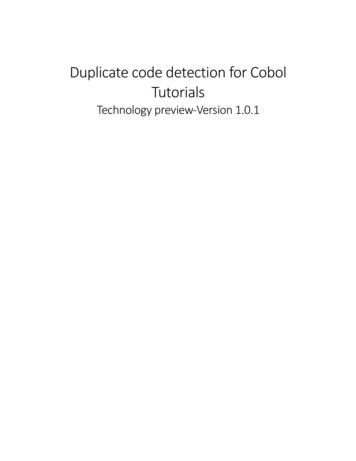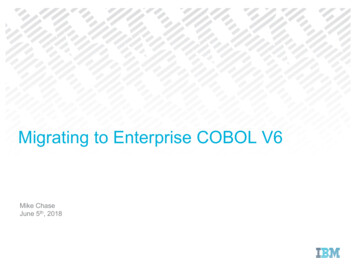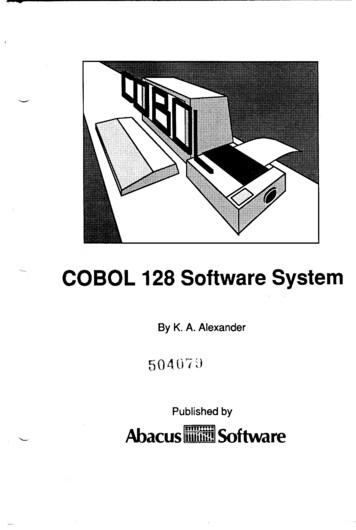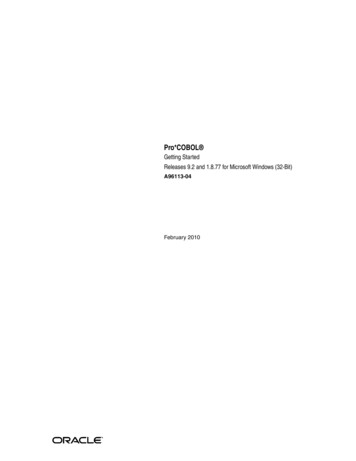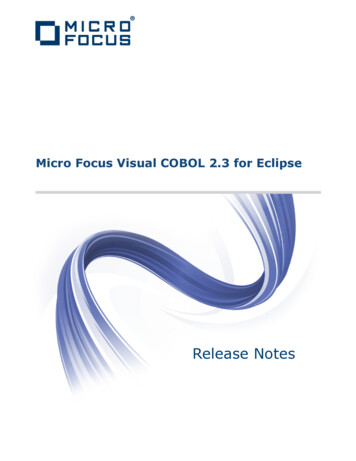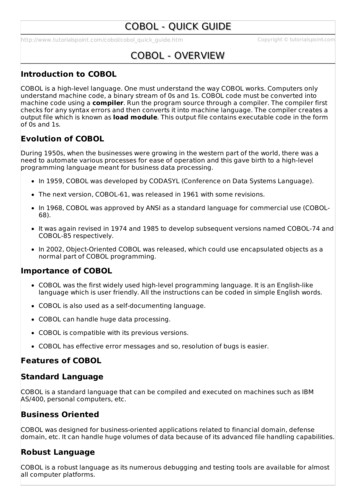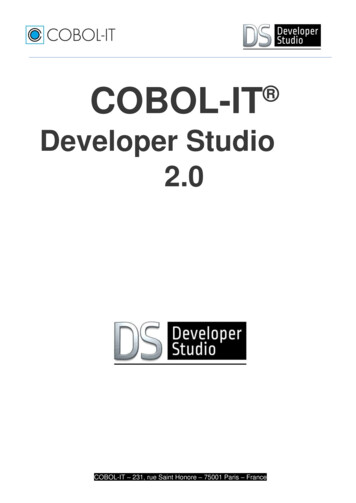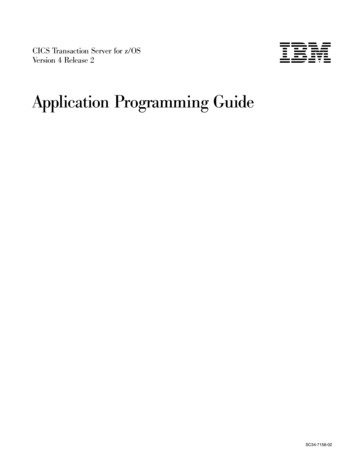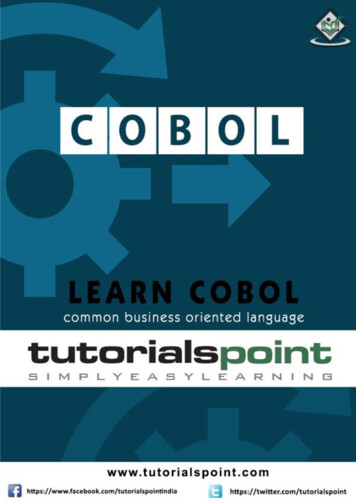
Transcription
About the TutorialCOBOL stands for Common Business-Oriented Language. The US Department ofDefense, in a conference, formed CODASYL (Conference on Data SystemsLanguage) to develop a language for business data processing needs which is nowknown as COBOL.COBOL is used for writing application programs and we cannot use it to writesystem software. The applications like those in defense domain, insurance domain,etc. which require huge data processing make extensive use of COBOL.AudienceThis tutorial is designed for software programmers who would like to learn thebasics of COBOL. It provides enough understanding on COBOL programminglanguage from where you can take yourself to a higher level of expertise.PrerequisitesBefore proceeding with this tutorial, you should have a basic understanding ofcomputer programming terminologies and JCL. A basic understanding of any ofthe programming languages will help you understand the concepts of COBOLprogramming and move fast on the learning track.Copyright & Disclaimer Copyright 2014 by Tutorials Point (I) Pvt. Ltd.All the content and graphics published in this e-book are the property of Tutorials Point (I)Pvt. Ltd. The user of this e-book is prohibited to reuse, retain, copy, distribute or republishany contents or a part of contents of this e-book in any manner without written consentof the publisher.We strive to update the contents of our website and tutorials as timely and as precisely aspossible, however, the contents may contain inaccuracies or errors. Tutorials Point (I) Pvt.Ltd. provides no guarantee regarding the accuracy, timeliness or completeness of ourwebsite or its contents including this tutorial. If you discover any errors on our website orin this tutorial, please notify us at contact@tutorialspoint.comi
Table of ContentsAbout the Tutorial ········ iAudience ······················· iPrerequisites ················· iCopyright & Disclaimer · iTable of Contents ········· ii1. OVERVIEW ························ 1Introduction to COBOL · 1Evolution of COBOL ······ 1Importance of COBOL ·· 1Features of COBOL ······· 22. ENVIORNMENT SETUP ······ 3Installing COBOL on Windows/Linux ····· 3Compiling COBOL Programs ·················· 3Executing COBOL Programs ··················· 4Executing COBOL-DB2 programs ··········· 4Try it Option Online ····· 63. PROGRAM STRUCTURE ····· 7Divisions ······················ 84. BASIC SYNTAX ················· 12Character Set ············· 12Coding Sheet ·············· 13Character �··········· 14Comment ··················· �···· 16COBOL Word ·············· 17ii
5. DATA TYPES ···················· 19Data Name ················· 19Level ················ 20Picture Clause ············ 21Value Clause ·············· 226. BASIC VERBS ··················· 24Input / Output Verbs · 24Initialize Verb ············· 25Move Verb ················· 26Legal Moves ··············· 28Add Verb ···················· 28Subtract Verb ············· 30Multiply Verb ············· 32Divide Verb ················ 33Compute Statement ··· 347. DATA LAYOUT ················· 36Redefines Clause ········ 36Renames Clause ········· 37Usage Clause ·············· 38Copybooks ················· 408. CONDITIONAL STATEMENTS ···················· 41IF Condition Statement ······················· 41Relation Condition ····· 42Sign Condition ············ 44Class Condition ·········· 45Condition-name Condition ·················· 46iii
Negated Condition ····· 47Combined Condition ·· 48Evaluate Verb ············ 499. LOOP STATEMENTS ········· 51Perform Thru ············· 51Perform Until ············· 52Perform Times ··········· 53Perform Varying ········· 54GO TO Statement ······· 5510. STRING HANDLING ·········· 57Inspect ······················· 57String ························· 59Unstring ····················· 6011. TABLE PROCESSING ········· 63Table Declaration ······· 63Subscript ···················· 65Index · 66Set Statement ············ 67Search ························ 69Search All ··················· 6912. FILE HANDLING ··············· 72Field ·· 72Record ······················· 73File ···· 7313. FILE ORGANIZATION ········ 74Sequential File Organization ··············· 74iv
Indexed Sequential File Organization ·· 75Relative File Organization ··················· 7514. FILE ACCESS ············ 77Sequential Access ······ 77Random Access ·········· 78Dynamic Access ········· 7915. FILE HANDLING VERBS ···· 81Open ···················· 81Read Verb ·················· 82Write Verb ················· 85Rewrite Verb ·············· 87Delete Verb ················ 89Start Verb ·················· 90Close Verb ·················· 9116. SUBROUTINES ················· 92Call Verb ···················· 92Call By Reference ······· 92Call By Content ·········· 94Types of Call ··············· 9517. INTERNAL SORT ··············· 96Sort ······················ 96Merge Verb ················ 9818. DATABASE �······· 101Embedded SQL ········· 101DB2 Application Programming ·········· 101Host Variables ·········· 101v
SQLCA ······················ 102SQL Queries ············· · 10919. INTERVIEW QUESTIONS ························· 112What is Next? ·········· 116vi
1. OVERVIEWIntroduction to COBOLCOBOL is a high-level language. One must understand the way COBOL works.Computers only understand machine code, a binary stream of 0s and 1s. COBOL codemust be converted into machine code using a compiler. Run the program sourcethrough a compiler. The compiler first checks for any syntax errors and then convertsit into machine language. The compiler creates an output file which is known as loadmodule. This output file contains executable code in the form of 0s and 1s.Evolution of COBOLDuring 1950s, when the businesses were growing in the western part of the world,there was a need to automate various processes for ease of operation and this gavebirth to a high-level programming language meant for business data processing. In 1959, COBOL was developed by CODASYL (Conference on Data SystemsLanguage). The next version, COBOL-61, was released in 1961 with some revisions. In 1968, COBOL was approved by ANSI as a standard language for commercialuse (COBOL-68). It was again revised in 1974 and 1985 to develop subsequent versions namedCOBOL-74 and COBOL-85 respectively. In 2002, Object-Oriented COBOL was released, which could use encapsulatedobjects as a normal part of COBOL programming.Importance of COBOL COBOL was the first widely used high-level programming language. It is anEnglish-like language which is user friendly. All the instructions can be codedin simple English words. COBOL is also used as a self-documenting language. COBOL can handle huge data processing.7
COBOL is compatible with its previous versions. COBOL has effective error messages and so, resolution of bugs is easier.Features of COBOLStandard LanguageCOBOL is a standard language that can be compiled and executed on machines suchas IBM AS/400, personal computers, etc.Business OrientedCOBOL was designed for business-oriented applications related to financial domain,defense domain, etc. It can handle huge volumes of data because of its advanced filehandling capabilities.Robust LanguageCOBOL is a robust language as its numerous debugging and testing tools are availablefor almost all computer platforms.Structured LanguageLogical control structures are available in COBOL which makes it easier to read andmodify. COBOL has different divisions, so it is easy to debug.8
2. ENVIORNMENT SETUPInstalling COBOL on Windows/LinuxThere are many Free Mainframe Emulators available for Windows which can be usedto write and learn simple COBOL programs.One such emulator is Hercules, which can be easily installed on Windows by followinga few simple steps as given below: Download and install the Hercules emulator, which is available from theHercules' home site : www.hercules-390.eu Once you have installed the package on Windows machine, it will create afolder like C:/hercules/mvs/cobol. RuntheCommandPromptC:/hercules/mvs/cobol on CMD. The complete guide on various commands to write and execute a JCL andCOBOL programs can be found cules/installmvs/instmvs2.htmHercules is an open-source software implementation of the mainframe System/370and ESA/390 architectures, in addition to the latest 64-bit z/Architecture. Herculesruns under Linux, Windows, Solaris, FreeBSD, and Mac OS X.A user can connect to a mainframe server in a number of ways such as thin client,dummy terminal, Virtual Client System (VCS), or Virtual Desktop System (VDS).Every valid user is given a login id to enter into the Z/OS interface (TSO/E or ISPF).Compiling COBOL ProgramsIn order to execute a COBOL program in batch mode using JCL, the program needsto be compiled, and a load module is created with all the sub-programs. The JCL usesthe load module and not the actual program at the time of execution. The loadlibraries are concatenated and given to the JCL at the time of executionusing JCLLIB or STEPLIB.9
There are many mainframe compiler utilities available to compile a COBOL program.Some corporate companies use Change Management tools like Endevor, whichcompiles and stores every version of the program. This is useful in tracking thechanges made to the program.//COMPILEJOB,CLASS 6,MSGCLASS X,NOTIFY &SYSUID//*//STEP1EXEC IGYCRCTL,PARM RMODE,DYNAM,SSRANGE//SYSINDD DSN MYDATA.URMI.SOURCES(MYCOBB),DISP SHR//SYSLIBDD DSN MYDATA.URMI.COPYBOOK(MYCOPY),DISP SHR//SYSLMODDD DSN MYDATA.URMI.LOAD(MYCOBB),DISP SHR//SYSPRINTDD SYSOUT *//*IGYCRCTL is an IBM COBOL compiler utility. The compiler options are passed usingthe PARM parameter. In the above example, RMODE instructs the compiler to userelative addressing mode in the program. The COBOL program is passed using theSYSIN parameter. Copybook is the library used by the program in SYSLIB.Executing COBOL ProgramsGiven below is a JCL example where the program MYPROG is executed using theinput file MYDATA.URMI.INPUT and produces two output files written to the spool.//COBBSTEPJOB CLASS 6,NOTIFY &SYSUID////STEP10EXEC PGM MYPROG,PARM ACCT5000//STEPLIBDD DSN MYDATA.URMI.LOADLIB,DISP SHR//INPUT1DD DSN MYDATA.URMI.INPUT,DISP SHR//OUT1DD SYSOUT *//OUT2DD SYSOUT *//SYSINDD *//CUST11000//CUST21001/*10
The load module of MYPROG is located in MYDATA.URMI.LOADLIB. This is importantto note that the above JCL can be used for a non-DB2 COBOL module only.Executing COBOL-DB2 programsFor running a COBOL-DB2 program, a specialized IBM utility is used in the JCL andthe program; DB2 region and required parameters are passed as input to the utility.The steps followed in running a COBOL-DB2 program are as follows: When a COBOL-DB2 program is compiled, a DBRM (Database Request Module)is created along with the load module. The DBRM contains the SQL statementsof the COBOL programs with its syntax checked to be correct. The DBRM is bound to the DB2 region (environment) in which the COBOL willrun. This can be done using the IKJEFT01 utility in a JCL. After the bind step, the COBOL-DB2 program is run using IKJEFT01 (again)with the load library and the DBRM library as the input to the JCL.//STEP001EXEC PGM IKJEFT01//*//STEPLIBDD DSN MYDATA.URMI.DBRMLIB,DISP SHR//*//input files//output files//SYSPRINT DD SYSOUT *//SYSABOUT DD SYSOUT *//SYSDBOUT DD SYSOUT *//SYSUDUMP DD SYSOUT *//DISPLAYDD SYSOUT *//SYSOUTDD SYSOUT *//SYSTSPRT DD SYSOUT *//SYSTSINDD *DSN SYSTEM(SSID)RUN PROGRAM(MYCOBB) PLAN(PLANNAME) PARM(parameters to cobol program) LIB('MYDATA.URMI.LOADLIB')11
END/*In the above example, MYCOBB is the COBOL-DB2 program run using IKJEFT01.Please note that the program name, DB2 Sub-System Id (SSID), and DB2 Plan nameare passed within the SYSTSIN DD statement. The DBRM library is specified in theSTEPLIB.Try it Option OnlineYou really do not need to set up your own environment to start learning COBOLprogramming language. Reason is very simple, we have already set up COBOLProgramming environment online, so that you can compile and execute all theavailable examples online at the same time, when you are doing your theory work.This gives you confidence in what you are reading and to check the result withdifferent options. Feel free to modify any example and execute it online.Try the following example using our Try it option available alongside the code in ourwebsite.IDENTIFICATION DIVISION.PROGRAM-ID. HELLO.PROCEDURE DIVISION.DISPLAY 'Hello World'.STOP RUN.When you compile and execute the above program, it produces the following result:Hello WorldFor some of the examples given in this tutorial, you will find a Try it option in ourwebsite code sections at the top right corner that will take you to the online compiler.So just make use of it and enjoy your learning. Try it option would work only withthe code compatible with OpenCOBOL. The programs that require JCL (Input file,Output file or Parameters) for execution would not run on Try it option.12
3. PROGRAM STRUCTUREA COBOL program structure consists of divisions as shown in the following image:A brief introduction of these divisions is given below: Sections are the logical subdivision of program logic. A section is a collectionof paragraphs. Paragraphs are the subdivision of a section or division. It is either a userdefined or a predefined name followed by a period, and consists of zero ormore sentences/entries. Sentences are the combination of one or more statements. Sentences appearonly in the Procedure division. A sentence must end with a period. Statements areprocessing. Characters are the lowest in the hierarchy and cannot be You can co-relate the above-mentioned terms with the COBOL program in thefollowing example:PROCEDURE DIVISION.A0000-FIRST-PARA SECTION.FIRST-PARAGRAPH.13
ACCEPT WS-ID- Statement-1MOVE '10' TO WS-ID- Statement-2DISPLAY WS-ID- Statement-3----- -- Sentence - 1----- .DivisionsA COBOL program consists of four divisions.Identification DivisionIt is the first and only mandatory division of every COBOL program. The programmerand the compiler use this division to identify the program. In this division, PROGRAMID is the only mandatory paragraph. PROGRAM-ID specifies the program name thatcan consist 1 to 30 characters.Try the following example using the Try it option online.IDENTIFICATION DIVISION.PROGRAM-ID. HELLO.PROCEDURE DIVISION.DISPLAY 'Welcome to Tutorialspoint'.STOP RUN.Given below is the JCL to execute the above COBOL program.//SAMPLE JOB(TESTJCL,XXXXXX),CLASS A,MSGCLASS C//STEP1 EXEC PGM HELLOWhen you compile and execute the above program, it produces the following result:Welcome to TutorialspointEnvironment DivisionEnvironment division is used to specify input and output files to the program. Itconsists of two sections: Configuration section provides information about the system on which theprogram is written and executed. It consists of two paragraphs:14
oSource computer : System used to compile the program.oObject computer : System used to execute the program.Input-Output section provides information about the files to be used in theprogram. It consists of two paragraphs:oFile control : Provides information of external data sets used in theprogram.oI-O control : Provides information of files used in the program.ENVIRONMENT DIVISION.CONFIGURATION SECTION.SOURCE-COMPUTER. XXX-ZOS.OBJECT-COMPUTER. XXX-ZOS.INPUT-OUTPUT SECTION.FILE-CONTROL.SELECT FILEN ASSIGN TO DDNAMEORGANIZATION IS SEQUENTIAL.Data DivisionData division is used to define the variables used in the program. It consists of foursections: File section is used to define the record structure of the file. Working-Storage section is used to declare temporary variables and filestructures which are used in the program. Local-Storage section is similar to Working-Storage section. The onlydifference is that the variables will be allocated and initialized every time aprogram starts execution. Linkage section is used to describe the data names that are received froman external program.COBOL ProgramIDENTIFICATION DIVISION.PROGRAM-ID. HELLO.15
ENVIRONMENT DIVISION.INPUT-OUTPUT SECTION.FILE-CONTROL.SELECT FILEN ASSIGN TO INPUT.ORGANIZATION IS SEQUENTIAL.ACCESS IS SEQUENTIAL.DATA DIVISION.FILE SECTION.FD FILEN01 NAME PIC A(25).WORKING-STORAGE SECTION.01 WS-STUDENT PIC A(30).01 WS-ID PIC 9(5).LOCAL-STORAGE SECTION.01 LS-CLASS PIC 9(3).LINKAGE SECTION.01 LS-ID PIC 9(5).PROCEDURE DIVISION.DISPLAY 'Executing COBOL program using JCL'.STOP RUN.The JCL to execute the above COBOL program is as follows://SAMPLE JOB(TESTJCL,XXXXXX),CLASS A,MSGCLASS C//STEP1 EXEC PGM HELLO//INPUT DD DSN ABC.EFG.XYZ,DISP SHRWhen you compile and execute the above program, it produces the following result:Executing COBOL program using JCLProcedure Division16
Procedure division is used to include the logic of the program. It consists ofexecutable statements using variables defined in the data division. In this division,paragraph and section names are user-defined.There must be at least one statement in the procedure division. The last statementto
For running a COBOL-DB2 program, a specialized IBM utility is used in the JCL and the program; DB2 region and required parameters are passed as input to the utility. The steps followed in running a COBOL-DB2 program are as follows: When a COBOL-DB2 program is compiled, a DBRM (Database Request Module) is created along with the load module.
